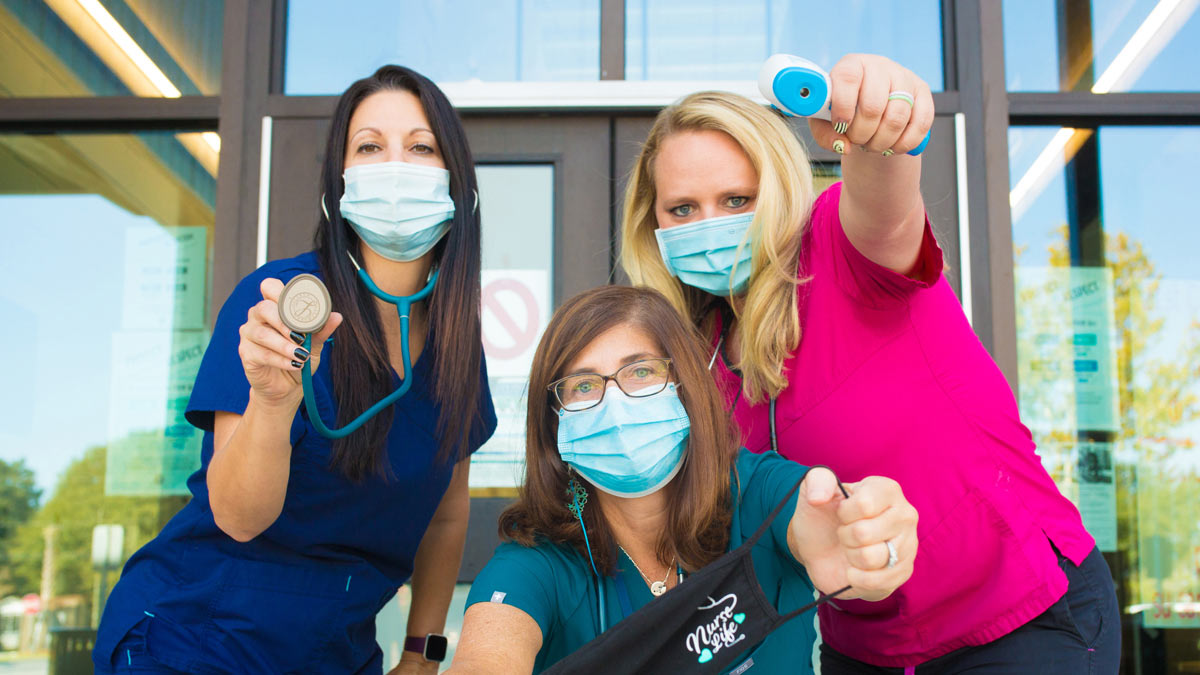The job of a school nurse has never been an easy one. Juggling any number of run-of-the-mill illnesses and injuries, contacting parents and dispensing medications in a busy school of several hundred students and faculty can be quite a challenge. Factor in the much-anticipated return to school during a global pandemic, and the world of school nursing has suddenly transformed into even more than what it had been.
“The challenges of COVID-19 have truly changed the function of our nursing practice,” explained Bonita Davies, BSN, RN, school nurse at Stiles Point Elementary School. “We are now tasked with being experts in public health and infection control. Our main priority has shifted to mitigating the spread of the disease. We accomplish this through educating, managing and guiding the staff, students and families of the district.”
“It also affects daily duties as far as making sure students are social distancing and wearing their masks appropriately,” added Caci Abercrombie, BSN, RN, school nurse at Mauldin Middle School. “We are out of the health room and in the halls more, trying to set an example and help the staff and students understand the importance of these new guidelines.”
School nurses, formerly simply in scrubs, are now prepared with personal protective equipment such as surgical face masks and face shields for daily interactions in the health room and also wear gloves and gowns in certain situations. Some school districts have installed plexiglass barriers and provided UV air purifiers for clinic areas.
As information and health requirements about the virus continue to change, school nurses must stay on top of the situation. They do so by following DHEC’s “Interim COVID-19 Guidance for Schools” to manage suspected or confirmed cases of the virus and to provide guidance for isolation, quarantine, testing, managing cases in classrooms and requirements to return safely to school. DHEC also provides guidance for school district reporting and contact tracing protocols.
In the Charleston County School District, for example, staff members or students who test positive for COVID-19 must stay out of school for 10 days and be directed to isolate themselves. School nurses and members of the district’s Nursing Services Department work together to trace and notify those who had close contact with that person. DHEC defines “close contact” as “being within 6 feet for 15 minutes or more to a COVID-19 case while contagious,” with or without face coverings.
Nurses also continually reinforce and teach appropriate mask use, social distancing and hand washing to students and staff.
Teachers and staff are operating at a heightened awareness of students who may be exhibiting symptoms of COVID-19, but school nurses have an appropriate plan in place to manage situations as they arise.
“We’ve devised a system to alert me visually to a symptomatic student before they enter the clinic, because it’s important to keep them separated from kids who may already be in there,” Davies explained. “This will also help maintain student confidentiality. If, after assessment, children are suspected to have COVID-19, they will be isolated in the clinic until they can be picked up by a parent. We anticipate this plan will need tweaking.”
The realities of being back in school during the pandemic make navigating contingency plans more challenging.
“The biggest challenge so far is that there are so many different ways that COVID presents,” said Abercrombie. “There is a long list of symptoms that can be seen with various other illnesses.”
Mask-wearing in schools is another challenge – not only is it a constant battle to remind students of all ages to keep their masks on and to wear them properly over their nose and face, but Abercrombie feels the masks often seem like a barrier to communication.
“It covers a warm smile that helps make a student feel loved and welcome. We enjoy taking extra time to talk with them and make sure their emotional needs are also being met. It is getting better every day, and the students are getting used to wearing masks. They have adapted very quickly and they are happy to be back in the school building with their friends and teachers.”
The COVID-19 pandemic has proven to have an ever-changing landscape as new details are discovered about its etiology, transmission and those who suffer most from the illness. It’s a major challenge for everyone but especially for school nurses as they continue to keep hundreds and sometimes thousands of students and faculty as safe as possible.
“As guidance changes, nurses must always be ready to respond and, at the same time, be the calming and knowledgeable force within schools,” said Davies. “This pandemic has definitely put us on the forefront. Ultimately, though, keeping schools open will be a community effort.”
By Anne Shuler Toole







